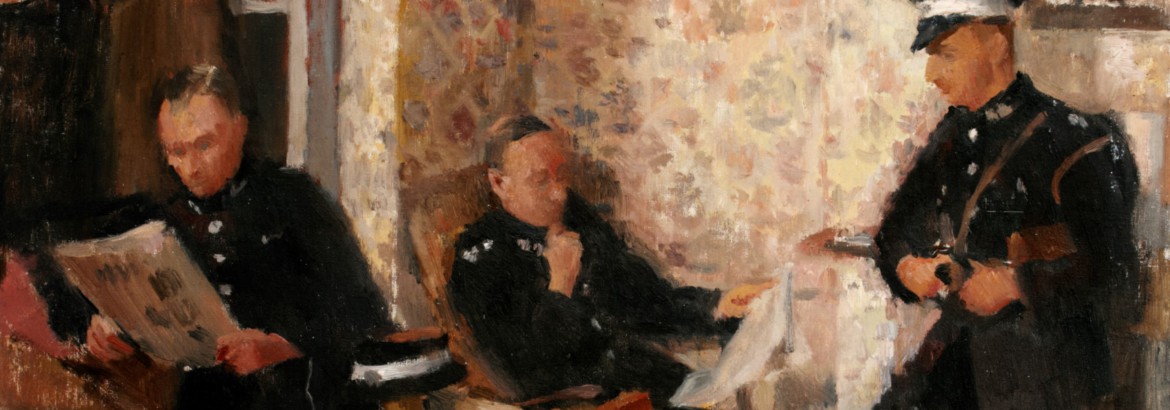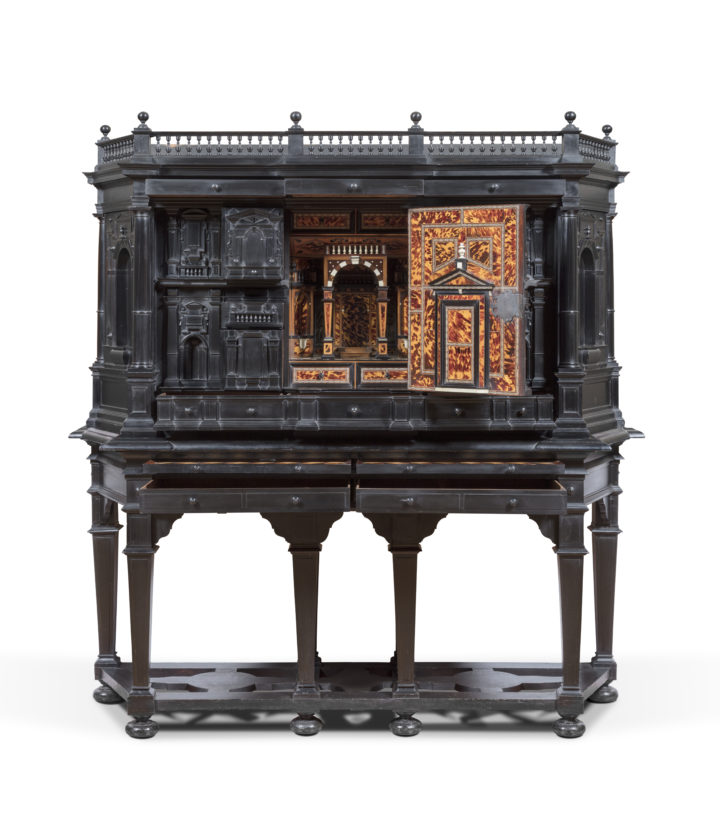The Spanish Cabinet is a seventeenth–century ebony cabinet with a beautiful interior. It currently stands in our Chapter Hall and is often featured on our public tours. In order to conserve the cabinet for the future, we keep it closed so this collection highlight offers a rare glimpse inside.
A History of the Cabinet
Although it is known as the “Spanish Cabinet”, the piece is actually Portuguese in origin. It was given to the Grand Master of the Order of St John, Nicholas Cotoner by the Regent King of Portugal, Pedro II in 1670. The cabinet was given as a diplomatic gift.
During the seventeenth century, Portugal had influence across the globe and controlled a large empire. Having gained independence from Spain in 1640, they were undergoing a period of imperial expansion and national consolidation. The cabinet is made from ebony, a dark wood that grew in several of the territories under Portuguese control, including parts of India, West Africa, Sri Lanka and Makassar, part of modern-day Indonesia.
Inside the Cabinet
The cabinet stands on eight legs with ball feet and stretchers. It has an ornate seventeenth-century baroque façade.


Opening the central doors reveals a mirrored interior ‘hall’ inlaid with tortoiseshell, ivory, ebony and various woods.


The arched ceiling of the ‘hall’ features cherubs holding the Coat of Arms of the Order of St John and the personal arms of Grand Master Nicholas Cotoner, who received the cabinet as a gift.


There are two figures painted on glass at the back of the hall, supported on four pillars. The woman in the photograph on the left is Diana, a roman goddess, and the women with the knife in her chest is Lucretia, a legendary roman noblewoman. Both are figures of female virtue.
Two parquetry tables with a tumbling block pattern can be found under the main table.
There are forty drawers in the cabinet made from oak. Those that are visible on the façade of the cabinet have an ebony front. Some of the drawers are hidden behind other drawers as you can see in the image below.


Nicholas Cotoner (1608 – 1680)
Upon the death of his Brother Rafael in 1663, Nicholas Cotoner became the 61st Grand Master of the Order of St John.
The Cotoners hailed from the island of Mallorca under the rule of the Kingdom of Aragon, part of Habsburg Spain during this period.
During his tenure as Grand Master, Cotoner worked to increase the prestige of the Order of St John Internationally. In 1674 he drew up the constitutions and statutes of the Order in Italian. The same year, he funded a School of Anatomy and Medicine in the annex of the Sacra Infermeria. Today, the University of Malta still has a Medical School which traces its history back to Cotoner’s School of Anatomy and Medicine.
In addition to this he oversaw extensive buildings works and renovations on the island of Malta. He directed the redecoration of St John’s Co-cathedral, a project begun by his brother. The vaults were painted by the Calabrian artist Mattia Preti who carved and guided many of the walls. The fortifications on the island were fortified under his leadership due to the fall of Candia in 1669, increasing fears of Ottoman invasion. Construction of the Cottonera Lines, named after him began under his leadership in 1670. The line of fortifications, built to protect Malta’s Three Cities, took almost a century to complete because of funding issues. They were built to accommodate 40,000 people and their animals in the case of invasion.
The portrait of Cotoner below is part of our collection. It was painted in the nineteenth-century. A Portrait Medal on display in the Order Gallery depicts him with a similarly distinct mustache.

The Grand Master’s Palace , Il-Palazz tal-Granmastru
The cabinet would have been displayed in the Grand Master’s Palace in Valletta, one of the first buildings to be constructed in Valletta when the city was founded in 1566. It served as the official residence of the Grand Masters of the Order of St John. It has been enlarged and renovated over time.
Today, the offices of the President of Malta are housed in the Palace. The State Rooms are open for members of the public to visit.
Conservation
This cabinet was extensively conserved in 2018, to ensure the cabinet’s condition was stable so it can be enjoyed for another 350 years.
A number of areas of fine decoration, including mouldings and inlay, had become detached from the cabinet over many years. Carefully collected and documented, it was possible for these sections to be reattached to the cabinet. Where a small number of pieces had been lost, these were carefully reproduced and replaced, if the loss interrupted the reading of the cabinet, or meant that it was more vulnerable to further damage. A number of areas of tortoise shell inlay in the interior was also lifting, becoming increasingly misshapen and prone to further damage. These areas were painstakingly re-secured to the cabinet, and continues to be monitored.
The intricate facade and interior was thoroughly cleaned and waxed, with scuffs and scraps delicately touched in so the bare wood blended with the beautiful ebony finish.
The final stage of conservation involved carefully fitting a tyvek (fabric) panel to the back of the cabinet, where some of the wooden backboard had been lost. It was important to ensure this was covered, to prevent dust from collecting in the interior of the cabinet.
The process of conservation revealed some fascinating facts about the cabinet, thanks to the expert knowledge of conservator Graham Marley. The most beautiful and costly materials would usually be reserved for the exterior of such pieces of furniture, with cheaper materials such as soft woods being used to make the carcass. This cabinet, however, has a carcass made of a more expensive hard wood, oak, which would have also been more times consuming and difficult for the craftsmen to work with.
The conservation of the Spanish Cabinet, and the photography included is this post, were made possible through a generous donation from the Anthony and Elizabeth Mellows Charitable Settlement, 2018.






